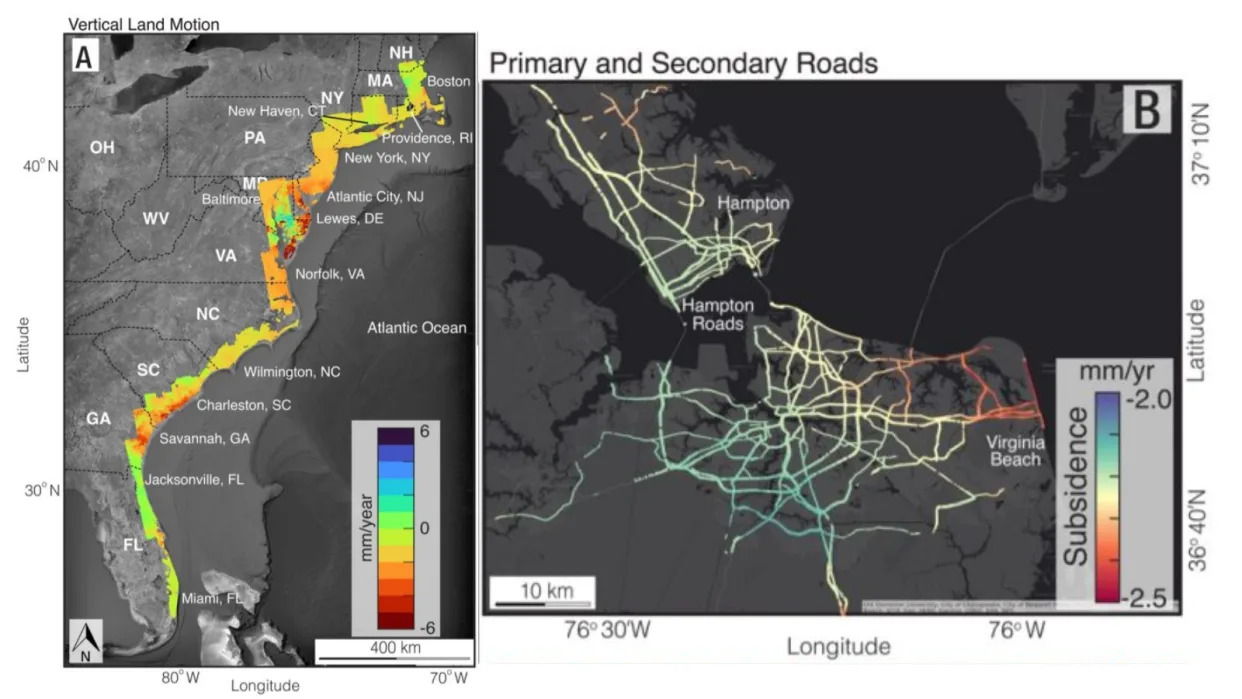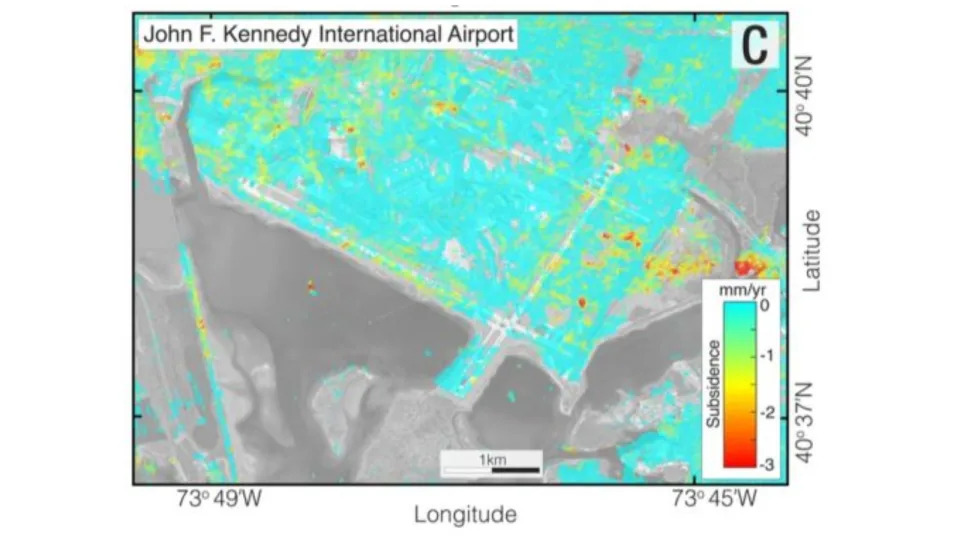Robert Lea
Thu, January 4, 2024 at 1:00 PM MST·3 min read

(Right) A map of vertical land motion on the East Coast (left) primary, secondary, and interstate roads on Hampton Roads, Norfolk, and Virginia Beach, Virginia with red and yellow indicating areas of sinking.
Images collected by numerous satellites have shown that major cities and population centers across the U.S. East Coast are sinking.
Land sinking, or "subsidence," as seen by these satellites, is dangerous because it can undermine the foundations of buildings, potentially causing collapse. It can also damaging roads as well as gas and water lines. When coupled with rising sea levels caused by human-driven climate change, subsidence in coastal regions can increase the risk of flooding and worsen subsequent damage.
Among the particularly hard-hit areas are New York City, Long Island, Baltimore, Virginia Beach, and Norfolk, which are experiencing areas of rapid subsidence next to slower-sinking regions and even stable patches of land. This poses a risk to infrastructure like roads, building foundations, pipelines, rail lines and even airport runways.
The new research from Virginia Tech and the U.S. Geological Survey (USGS) shows that some areas of the U.S. East Coast are sinking as rapidly as 5 millimeters (0.2 inches) per year, a rate of subsidence at the edge of the Atlantic Ocean that outstrips global sea level rise.
Related: Satellites watch as Japan's new volcanic island continues to grow (image)
"Continuous unmitigated subsidence on the U.S. East Coast should cause concern,” Leonard Ohenhen, research lead author and a graduate student at the Virginia Tech Earth Observation and Innovation Lab, said in a statement. "This is particularly in areas with a high population and property density and a historical complacency toward infrastructure maintenance."
A sinking feeling
Together with Virginia Tech Earth Observation and Innovation Lab Associate Professor Manoochehr Shirzaei, Ohenhen and colleagues collected a huge amount of data from space-based radar satellites to build digital maps of terrain.
They then measured millions of subsidence occurrences over many years, following up by constructing some of the first-ever high-resolution images of sinking land.
The team's maps showed that a large number of U.S. East Coast areas sinking by at least 2 mm (0.08 in) per year. Additionally, the scientists found areas along the mid-Atlantic coast, amounting to over 1,400 square miles (3,626 square kilometers), that are sinking by 5 mm (0.2 in) per year or more. The current rate of global sea-level rise, which is around 4 mm (0.16 in) per year.
"We measured subsidence rates of 2 millimeters per year affecting more than 2 million people and 800,000 properties on the East Coast," Shirzaei said. "We know to some extent that the land is sinking. Through this study, we highlight that sinking of the land is not an intangible threat. It affects you and I and everyone, it may be gradual, but the impacts are real."

John F. Kennedy International Airport, New York as seen from space with red and yellow indicating regions of subsidence
Ohenhen pointed out how the problem with the subsidence mapped isn't just that land is sinking, but also that "hotspots" of subsidence are occurring in population hubs and around concentrations of infrastructure.
"For example, significant areas of critical infrastructure in New York, including JFK and LaGuardia airports and its runways, along with the railway systems, are affected by subsidence rates exceeding 2 mm per year," he added. "The effects of these right now and into the future are potential damage to infrastructure and increased flood risks."
related stories
— Greenland ice sheets are weaker to climate change than we thought
— Doomsday Glacier melting in Antarctica means terrible news for global sea level rise
— Satellite data and 100-year-old images reveal quickening retreat of Greenland's glaciers
"This information is needed. No one else is providing it," USGS research geologist and study co-author Patrick Barnard said in the statement. "Shirzaei and his Virginia Tech team stepped into that niche with his technical expertise and are providing something extremely valuable."
The team's research was published on Tuesday (Jan. 2) in the journal Proceedings of the National Academy of Sciences.
No comments:
Post a Comment